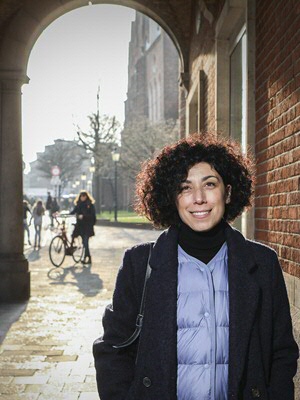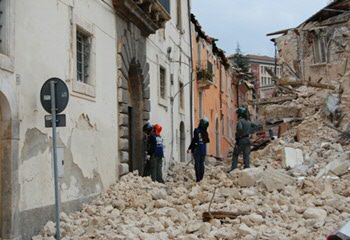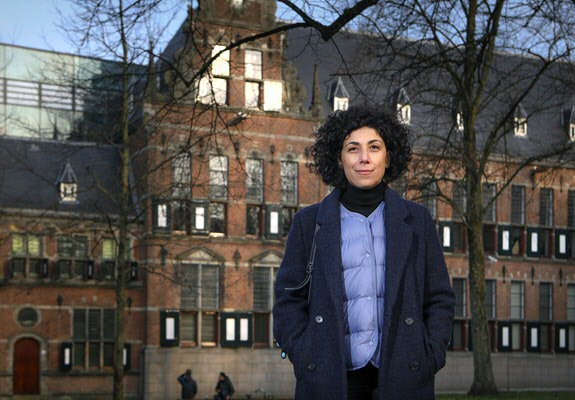Why is crisis communication so difficult?

What is best way for authorities to communicate about potential crisis situations? Francesca Giardini has been pondering this question since experiencing the after-effects of an earthquake in her home city. She is studying how social interaction increases or reduces people's perception of danger. She hopes that this will give us a better understanding of human behaviour in situations such as the current coronavirus pandemic.
Text: Beau Oldenburg / Photos: Henk Veenstra
Earthquake
On 6 April 2009, the Italian city of L’Aquila, the birthplace of Francesca Giardini, sociologist at the University of Groningen (UG), was devastated by an earthquake. Over 300 people lost their lives. The inhabitants of L’Aquila had been feeling slight tremors throughout the months leading up to the earthquake. Although in the past, tremors like these had been seen as a warning of a more serious earthquake, the authorities maintained that there was no reason to panic.
Trust
Over 11 years later, inspired by this life-changing event (as well as the earthquake issues in Groningen and the coronavirus pandemic), Giardini decided to conduct research into crisis communication. ‘Things obviously went very wrong in L’Aquila. The authorities repeatedly stated that there was no cause for concern, so most people were in their homes at the time of the earthquake. We had been through earthquakes before, so we knew that it would be safer to go outside and even spend a night sleeping in the car if necessary. Looking back, our level of trust in the authorities was bizarre.’

Not real people, but ‘agents’
Giardini’s research revolves around people’s individual risk perception; the level of danger that individuals perceive. As a sociologist, she is particularly interested in how social interaction affects this perception. As this is quite difficult to study in people, she is using so-called ‘agent-based models’, which simulate people’s opinions and behaviour. In Giardini’s models, the simulated people (also known as agents) are given information about the chances of a particular disaster taking place. They then ‘talk’ to each other about it. Giardini: ‘You see the risk perception of the simulated individuals slowly but surely changing as they communicate with each other. These subtle changes are very difficult to monitor in real people.’
Alarmists
Giardini noticed that as people influenced each other, clusters of like-minded people were formed. For example, a group of alarmists emerged. These people perceive a high threat level, much higher than is actually the case, and have very little faith in the authorities. They are also able to ‘infect’ other people with their panic. Contact with an alarmist makes people more frightened. Giardini: ‘This is probably because alarmists are very vocal about the threat that they perceive. On the one hand, they want to inform people about what is going on, and on the other hand, they want to reassure themselves.’
Conspiracy theorists
Conspiracy theorists are another interesting group. Like alarmists, they do not trust the authorities. But this group does not perceive a threat. Giardini: ‘The people in this group have very little faith in the authorities, but they would trust each other with their lives. They are very difficult to reach as their scepticism becomes entrenched in their identities. Their beliefs are much more than simple opinions. This is why the information that you issue doesn’t get through to them; their radars are not tuned to receive it.’

Coronavirus pandemic
Giardini’s research could help us to understand people’s behaviour during the coronavirus pandemic. Why, for example, do some people completely deny the existence of the pandemic and blatantly ignore the restrictions, while others have spent a year isolating themselves? Giardini: ‘My study shows that information is not always received in the way that it is intended. Some people are so scared that the information becomes distorted. Other people trust what other people say more than they trust the information from official sources.’
Being open about risks
According to Giardini, the biggest challenge facing governments is finding a way to be open and transparent about risks, without scaremongering. ‘I heard that they had exaggerated the risks in Germany to make people comply with the rules. This is a dangerous strategy, which could cause people to hide away at home, or start rioting or looting. My advice is to stick to the facts. At the same time, you must be aware that people may not interpret a message in the way that you’d hoped.’
Understanding the opportunities
Giardini also thinks that it would be a good idea to focus more attention on interpreting opportunities. ‘I think that a lot of people find this tricky. When communicating risks, it might be beneficial to pay more attention to how people are supposed to interpret your message. If people really understand the risks, they will be able to make a balanced judgement. Having said this, my study shows that risk perception goes a lot further than individual comprehension.’
More information
- Francesca Giardini
- Francesca Giardini and UG colleague Clara Egger are organizing a summer school entitled Cascading Disasters, Institutions and Organizations Towards resilient organizations, institutions and societies from 5 to 9 July.
More news
-
08 December 2025
Citizen participation essential for a sustainable energy future
-
23 October 2025
Nine UG researchers awarded Vidi grant
